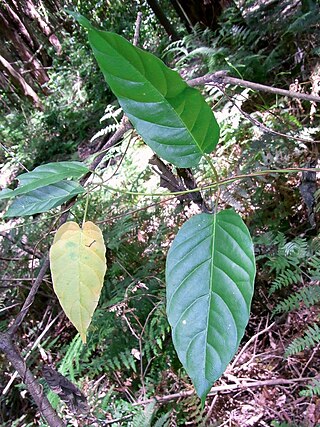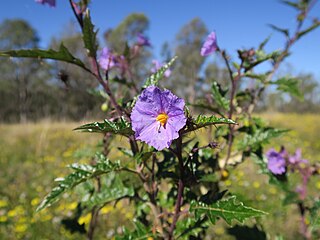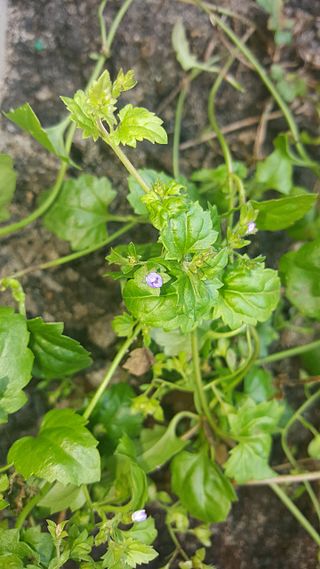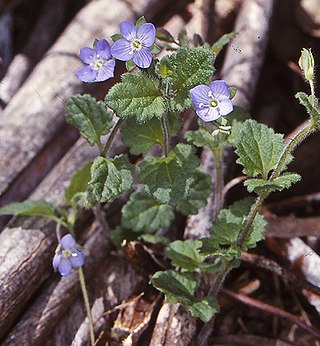
Prostanthera incisa, commonly known as cut-leaf mint-bush or native thyme, is a species of flowering plant in the family Lamiaceae and is endemic to south-eastern continental Australia. It is an erect, strongly aromatic, openly branched shrub with hairy, densely glandular branches, egg-shaped to oblong leaves, and pale mauve to mauve flowers.

Lobelia purpurascens, commonly known as white root or purplish pratia, is a flowering plant in the family Campanulaceae of eastern Australia. It is a small herbaceous, scrambling plant with white to pale pink flowers.

Parsonsia straminea, commonly known as common silkpod or monkey rope, is a woody vine of the dogbane family, Apocynaceae. It occurs in the states of New South Wales and Queensland in Australia.

Lyperanthus, commonly known as beak orchids, is a genus of flowering plants from the orchid family, Orchidaceae, that is endemic to Australia. There are two species, one in Western Australia and the other in four eastern Australian states, distinguished by their single long, narrow, leathery leaf and dull coloured flowers which have prominent short calli on their labellum. Both form loose colonies which reproduce asexually from their tubers, and sexually using their flowers.

Pseuderanthemum variabile, commonly known as pastel flower or love flower in its native range, or night and afternoon in the USA, is a small perennial herb in the family Acanthaceae which is native to Australia, Papua New Guinea and New Caledonia. It can be an unwelcome nuisance in orchid nurseries in Australia.

Solanum pungetium, known as the eastern nightshade is a small, low spreading plant native to the east coast of Australia.

Orthoceras strictum, commonly known as the bird's-mouth orchid or horned orchid, is a species of orchid native to eastern and southern Australia, New Zealand and New Caledonia. It has between two and five linear leaves and up to nine yellowish green, brownish or blackish flowers with two long, erect to spreading lateral sepals.

Vincetoxicum barbatum, synonym Tylophora barbata, the bearded tylophora, is a small vine in the dogbane family. A common plant found south of Bulahdelah, New South Wales. The habitat is rainforest and moist eucalyptus forests in south eastern Australia. Not often seen in flower, but flowers are dark red, around 7 mm long on thin stalks. Broken branches produce watery or milky sap.

Persoonia laurina, commonly known as the laurel-leaved or laurel geebung, is a shrub of the family Proteaceae native to central New South Wales in eastern Australia. Found in sclerophyll forest, it grows to a height of 2 metres. The yellow flowers appear in late spring.

Leichhardtia rostrata, synonym Marsdenia rostrata, is a common climbing plant found in eastern Australia. This member of the dogbane family features white milky sap, when leaves are broken from the stem. It is found in a variety of habitats in relatively high rainfall areas, including rainforest and wet eucalyptus forest. Widespread in distribution in coastal regions, though it also appears inland in places such as the Liverpool Range. It may grow to ten metres tall, with a woody stem up to 4 cm wide. Leaves range from 4 to 13 cm long and 2 to 7 cm wide. The fruit is somewhat pear shaped, 5 cm by 2.5 cm.

Solanum cinereum, commonly known as Narrawa burr, is a species of flowering plant in the family Solanaceae. It has dark green, spiny leaves and purple flowers and grows in open woodland in south eastern Australia.

Schizaea rupestris is a small Australian fern. Most populations are in found in the ranges near Sydney. However, it also occurs near Woolgoolga and Western Australia.

Veronica plebeia, commonly known as creeping- or trailing speedwell, is a species of flowering plant belonging to the family Plantaginaceae. It is native to Australia and New Zealand.

Veronica calycina, commonly known as hairy speedwell or cup speedwell, is a flowering plant in the family Plantaginaceae. It is a trailing perennial with dark green leaves, purple-blue flowers and is endemic to Australia.

Leucopogon affinis, commonly known as lance beard-heath and formerly known as Leucopogon lanceolatus is a flowering plant in the heath family Ericaceae and is endemic to eastern Australia, including Tasmania and South Australia. It is an erect shrub with spikes of small white flowers in early spring, followed by orange-red fruit.

Chorizandra sphaerocephala, the roundhead bristle-sedge, is a species of perennial herb, found in swampy areas in eastern Australia. An erect rush-like plant from 50 to 110 cm tall, it has tough rhizomes and flower from spring to summer. This is one of the many plants first published by Robert Brown with the type known as "(J.) v.v." Appearing in his Prodromus Florae Novae Hollandiae et Insulae Van Diemen in 1810. The specific epithet sphaerocephala refers to the rounded heads.

Chloanthes stoechadis is a species of flowering plant in the family Lamiaceae. It is a small under shrub with wrinkled leaves and yellowish green flowers.
Chloanthes glandulosa is a species of flowering plant in the family Lamiaceae. It is a small shrub with wrinkled leaves and greenish-yellow tubular flowers. It is endemic to New South Wales.

Styphelia appressa is a species of flowering plant in the heath family Ericaceae and is endemic to south-eastern New South Wales. It is a small, spreading to erect shrub with wiry stems, lance-shaped or narrowly egg-shaped to elliptic leaves and small white flowers.

Styphelia biflora is a species of flowering plant in the heath family Ericaceae and is endemic to eastern Australia. It is an erect to spreading shrub with hairy branchlets, oblong leaves and small white flowers.





















